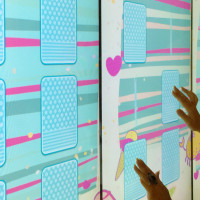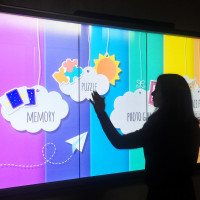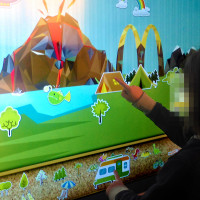
RETAIL
Choose the evolution in retail
Find out how we can help you create new in-store experiences that win over consumers and add value to your brand.
Barcodes are unique codes that allow you to identify a product via a simple sequence of black and white bars. Barcodes were first created in the United States at the end of the 40s, but they weren’t perfected and diffused until 1974. Today, there are still the cheapest and fastest way to identify an item. In the digital age, however, there is a fundamental weak point: it must be read.
Each code must go through an optical reader and although the operation may seem easy and fast, it must be repeated for each item by a person, increasing time and costs. Just think of stores, where large packages frequently arrive with numerous products: each box must be opened and the barcode on each item needs to be identified and scanned by the optical reader.
Multiply this operation throughout the life of the product, from when it leaves the factory to your shopping cart, and you will get an idea of the amount of time and work it requires even just to inventory the goods in the store. In addition, manually recording exposes you to high error possibilities. Furthermore, barcodes hold an extremely limited amount of information. In the age of digital communication, this can be a serious problem.
The direct heir of the barcode is the QR Code, short for Quick Response Code. It is a simple white square that has various arranged black and white squares. It is increasingly common to find these codes everywhere: on train tickets, on product packaging, on advertising pages. It can hold much more information compared to the barcode and it can be read by the simple camera lens of a tablet or smartphone. Each code can contain images, links, data, allowing a quick passage of information. The immediacy of the QR Code and its universality (all you need is a smartphone to use it) make it perfect for promotions and in-depth information. However, it is only one-way communication, which does not meet the needs of dialog between objects.
The Digital Transformation brought about new ways to allow objects to communicate with each other and digital devices like smartphones and tablets were created. The goal of these retail technologies is to improve security by avoiding theft and forgery; streamline management, speeding up inventories, orders and restocking; facilitate pricing, enabling rapid price updates; involve consumers, creating new experiences and stimulating dialog.
The term IOT, short for the Internet of Things, includes different technological systems and software platforms that allow objects to communicate with each other without being physically connected, but rather, connected to a network. The sector is currently booming, having reached € 5 billion in 2018, according to data from the Politecnico di Milano Observatories. This is an increase of 35% compared to the previous year.
Basically, IOT systems provide for the unambiguous identification of the object using a physical device, wireless technology and software that can be connected to a management system. The most common identification device of an item in the retail environment is the price tag. By integrating a small antenna and a bit of memory, you can make it smart. Here, we're talking about the RFID radio frequency label, which uses UHF frequencies to emit a signal and convey information that can be read by special scanners, even through the most common packaging.
This system has opened the door to new possibilities, such as the monitoring of every movement of a garment, when the store is equipped with scanning devices at the exit and in the fitting rooms. Knowing how many and what items are brought into the dressing room and into/out of the store drastically reduces the risk of theft. Moreover, it avoids the risk of fakes and it speeds up the management of the warehouse, shipments and price fluctuations. The label can also activate the digital environment screens of the store, displaying multimedia content associated with the product, making the shopping experience more enjoyable and engaging.
Among the various communication systems between objects, NFC technology, Near Field Communication, is the one that offers short-range wireless connectivity automatically, the "hooking" operation of a bluetooth device, without a password or pairing. Compared to RFID, NFC technology means you can open dialog between a device and not a simple unambiguous passage of information. The proximity of the two devices, from 10 to 4 centimeters, allows safe and low-consumption data exchange, which is a fundamental requirement for devices with limited energy autonomy such as smartphones. Consumption for bluetooth connection is certainly greater and occurs on the very crowded 2.4 GHz band, the same as Wi-Fi antennas and many other devices. Data exchange is slower compared to bluetooth though (424 kbits per second), so the quantity of data to be exchanged is more limited. Integrated in a smartphone, NFC allows cashless and cardless payments by simply bringing it closer to the POS terminal, but there are many other possibilities.
NFC facilitates and speeds up mutual identification between devices: it works with smartphones and tablets, but also with speakers or audio headsets, cameras, printers, hard disks and so on. NFC tags placed inside shops or shopping malls can communicate with visitors' smartphones, conveying content and promotions. In the business environment, they can become electronic business cards, transmitting data directly to the interlocutor's smartphone, or in the museum environment to provide in-depth information along the exhibition routes.
The Digital Transformation is progressively making any object smart, turning it into a sort of connection point between consumers, brands and companies. The continuous exchange of information generated by this connection produces an enormous volume of data which, if appropriately managed and interpreted, can favor the creation of increasingly advanced services that are close to the real needs of consumers.

Find out how we can help you create new in-store experiences that win over consumers and add value to your brand.

Recreation areas for children, playgrounds where young guests can play and compete with one another.

At Kiddy Zone you'll find all the toys you need, especially interactive ones!

Creating a digital entertainment area for children, where they can tackle new challenges and socialize.